The Toronto Maple Leafs made a huge splash on July 1 when they traded away Calle Rosen and Nazem Kadri, the team’s longest-serving player, for Tyson Barrie and Alexander Kerfoot. Barrie, a dynamic right-handed defenceman, is considered the crown jewel of the trade – perhaps rightfully so. But the secondary piece, Kerfoot, is just as intriguing and will fill an important role for the Maple Leafs next season.

Most fans and analysts seemed to have already penciled in Kerfoot as Toronto’s third-line centre of the future, but are they jumping to conclusions? Is Kerfoot really capable of replacing a two-time 30-goal scorer in Kadri? And maybe, more importantly, is Kerfoot even an NHL centreman?
What Do the Stats Say?
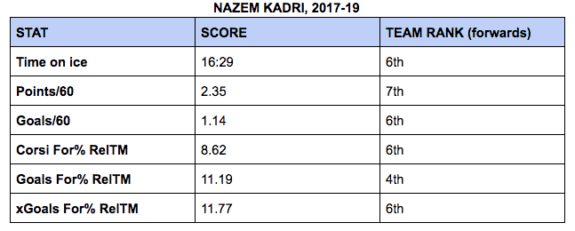
On aggregate, Kadri comes out as about the Maple Leafs’ sixth-best forward over the last two seasons. He’s been productive while also driving play at a high level. Where does Kerfoot stack up in comparison?
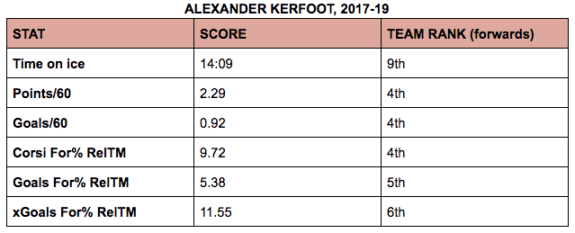
While Kerfoot hasn’t been tasked with the same ice time as Kadri, playing just over 14 minutes per night, he still emerges as a top-five forward during his time with the Colorado Avalanche. Like Kadri, he drives shots and goals at exceptional rates, although he scores a bit less.
On the whole, the two players aren’t all that different – at least statistically. The real discrepancy between the two is how they arrive at their results.
Playing Styles
While both Kadri and Kerfoot produce and drive results like top-six forwards, they do so in very different ways. For the most part, Kadri has never been a strong defensive player as he relies on his offensive skills to simply out-chance the opposition. In comparison, Kerfoot is a relatively average driver of offence, but he gives his team a huge boost in the defensive end by allowing very few shots and chances against. And if you’re going by expected goal impacts alone, Kerfoot actually beats Kadri out quite substantially thanks to his defensive prowess.

The shot chart from Hockey Viz clearly illustrates just how effective Kerfoot is at limiting high danger shots against. This season the Avalanche were just about average defensively without Kerfoot. When he was on the ice, though, they allowed far fewer shots against, especially from the slot.
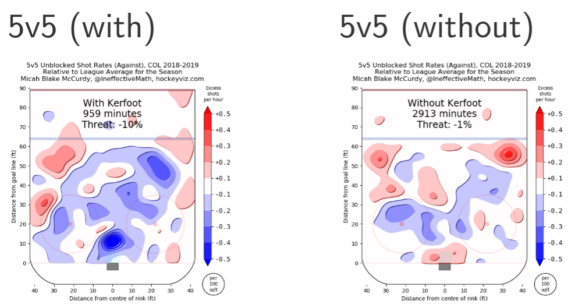
And while defence isn’t necessarily the sexiest attribute for a forward to have, good results are good results. At 5-foot-10, Kerfoot won’t be laying opponents out like Kadri did on an almost nightly basis, but he is still a smart, skilled, and exceptionally effective player.
Age, Contracts, and Future Value
One crucial factor that’s been somewhat overlooked in this trade is the age of the players involved. Kadri is still relatively young at 28, but he’ll be 29 in October – one more step towards his statistical decline. In fact, research has shown that, on average, NHL forwards peak around 23 to 25 and gradually decline after that. And while Kadri will certainly be a useful player into his early 30s, he’s likely already seen his best years.
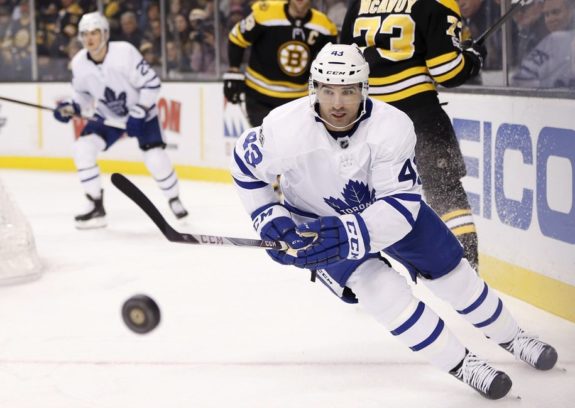
Kerfoot, on the other hand, will turn 25 in August and is going into just his third NHL season. Given his age, the fact that he’s still figuring out the NHL game, and that he’s joining a high-octane Maple Leafs team where he’ll be playing with better linemates, Kerfoot may be poised to have a breakout season.
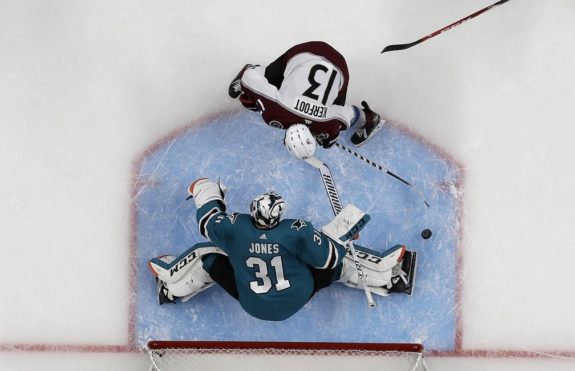
It almost seems counterintuitive that Kadri was traded considering his bargain of a contract: He’s signed for three more seasons at $4.5 million. The key for the Maple Leafs, though, was inking Kerfoot to a four-year extension at just $3.5 million per season. The Vancouver-native will be making $1 million less than Kadri while providing much better defence and comparable offence. For a team that’s going to need to maximize every dollar of cap space, that extra $1 million could be invaluable to the Maple Leafs.
Maple Leafs’ Third Line Usage
General manager Kyle Dubas has sent a clear message with some of his moves this summer, and it’s become apparent that he wants to see some changes on the ice. The Kadri trade is just another episode in that series of moves. This time, Dubas is making it clear that he wants more ice time allocated to his top-two lines.
This past season, John Tavares played 19:05 per game while Auston Matthews played just 18:33. That doesn’t sound too bad on paper until you consider this: the only time Tavares played less than 2018-19 was in 2009-10, as a 19-year old rookie. And of course, there were the rumors that Matthews complained about his lack of ice time last summer. Player deployment has been a long-time issue for head coach Mike Babcock, but it’s time for him to evolve. Dubas is trying to help that process along.

If we expect both Tavares and Matthews to get a boost in ice time next season to around 20 minutes each, that leaves even less 5-on-5 ice time for the third and fourth lines to split. Kadri, a bonafide second-line centre, was arguably being wasted on the third line last season as he played just 16:11 per night, even with plenty of time on the first power-play unit. It simply made sense to cash in on Kadri’s trade value given that his skillset no longer matched up with his role in Toronto.
Meanwhile, Kerfoot is better suited to third line deployment as he’s averaged 14:09 of ice time over his first two seasons. Assuming he is in fact used on the Maple Leafs’ third line, Kerfoot will probably see anywhere from 12 to 15 minutes per game, depending on his special teams deployment. This will rightfully leave Tavares and Matthews with the lion’s share of work, while still allowing the younger, cheaper Kerfoot to flourish in his role.
Can Kerfoot Actually Play Centre?
Leaving maybe the most important question for last: Can Kerfoot even play centre? Well, it’s complicated.
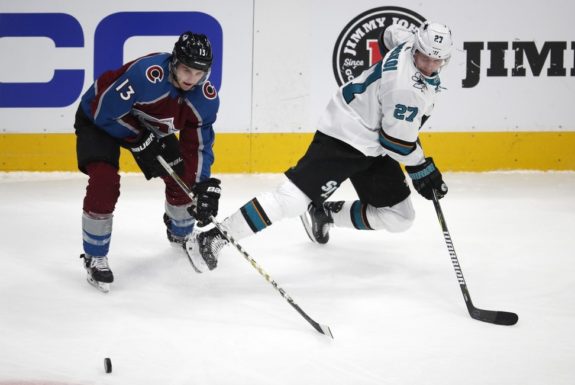
According to Ian Tulloch of The Athletic, Kerfoot took either five or six even-strength faceoffs in 41 games, but took eight or more faceoffs just 20 times this past season (from ‘Tulloch: How Alexander Kerfoot can fill the third-line centre role for the Maple Leafs,’ The Athletic – 7/10/19). It’s a simplistic and imperfect way to define who is playing centre on a line (given the fact that wingers can also take faceoffs, like William Nylander who takes strong-side draws when paired with Matthews), but it’s nearly impossible to decipher just how much time Kerfoot spent at centre without watching all of his games from start to finish.
What we do know about Kerfoot and his ability at centre is this: He’s incredible at faceoffs (56 percent this season, 12th best in the league), he’s a defensive powerhouse, and he’s excellent at transitional play (which is key for a centreman, who usually gets the most touches on his line).
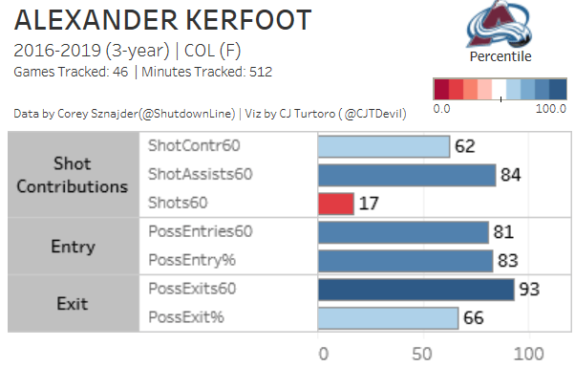
All of this points to the notion that whether he’s played much at centre or not, Kerfoot is at least deserving of a chance to start the season as Toronto’s third-line pivot. So go ahead and pencil him into your projected lineups – you have my permission.
The Maple Leafs have already made plenty of personnel changes with 12 fresh faces brought in since July 1. And while Kerfoot may not be the biggest name in the league, he’s going to need to be a key cog for the Maple Leafs if they want to take another step next season.
Player stats from Hockey-Reference and Natural Stat Trick